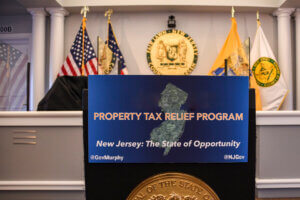West Long Branch, NJ – New Jersey voters say they would support a constitutional provision to require the state to meet its full public employee pension payment each year. Yet, the Monmouth University Poll also finds when it comes to making a choice between the pension obligation and other key government services, Garden State voters would opt for fully funding those other services over state pensions.
Currently, 71% of registered voters in New Jersey say they would vote for a constitutional amendment that would require the state to always make its full annual payment for state worker pensions. Just 18% say they would oppose it. Support comes from 82% of Democrats, 70% of independents, and 56% of Republicans. The state legislature passed a resolution ( SCR184 ) on the pension obligation question in January. It would need to be passed again in the next few months in order to appear on November’s ballot.
“At first glance there appears to be widespread support for constitutionally guaranteeing that the full pension obligation is met in each annual budget. However, it is not clear that voters really comprehend that approving this measure would mean pension payments would automatically take precedence over funding other key services,” said Patrick Murray, director of the independent Monmouth University Polling Institute.
Voters do say that fully meeting the pension obligation would lead to cuts elsewhere. Just over one-third (36%) say that it is very likely and another 39% say it is somewhat likely that other items in the state budget would need to be significantly cut if the state was required to make its full annual pension payment. However, if they had to make the choice between fully funding the pension obligation and fully funding three other services, the pension system comes out on the losing end each time.
Specifically when pitted against fully funding aid to local schools, only 25% would make the full pension payments while 63% would fund the schools. When pitted against fully funding services for the poor, only 28% would make the full pension payments while 58% would fund services for the poor. When pitted against fully funding needed road and bridge repairs, only 30% would make the full pension payments while 59% would fund roads and bridges. These preferences span Democrats, Republicans, and independents alike.
“New Jersey voters support the principle of meeting our obligation to public employees, but it is not at all clear they understand how this constitutional amendment would tie Trenton’s hands when it comes to weighing these obligations against other expenditures. And they won’t understand it when they walk into the voting booth, since the wording of the proposed ballot question and interpretive statement says nothing about these probable trade-offs,” said Murray.
The Monmouth University Poll was conducted by telephone with 806 New Jersey adults from May 23 to 27, 2016. This release is based on a sample of 703 registered voters and has a margin of error of ± 3.7 percent. The poll was conducted by the Monmouth University Polling Institute in West Long Branch, NJ.
DATA TABLES
The questions referred to in this release are as follows:
(* Some columns may not add to 100% due to rounding.)
[ Q1-13 previously released. ]
Looking ahead to November, some initiatives seeking voter approval may also appear on the state ballot.
14.Would you vote for or against a constitutional amendment that would require the state to always make its full annual payment for state worker pensions by 2021?
|
TOTAL |
PARTY ID | |||
|
|
Rep |
Ind |
Dem | |
| For |
71% |
56% |
70% |
82% |
| Against |
18% |
26% |
21% |
9% |
| (VOL) Will not vote |
1% |
1% |
1% |
0% |
| (VOL) Don’t know |
11% |
17% |
8% |
9% |
15.If the state was required to make its full annual pension payment, how likely would it be that other items in the state budget would need to be significantly cut – very likely, somewhat likely, not too likely, or not at all likely?
|
TOTAL |
PARTY ID | |||
|
|
Rep |
Ind |
Dem | |
| Very likely |
36% |
42% |
40% |
28% |
| Somewhat likely |
39% |
42% |
38% |
38% |
| Not too likely |
9% |
3% |
6% |
16% |
| Not at all likely |
8% |
6% |
8% |
9% |
| (VOL) Don’t know |
8% |
6% |
8% |
8% |
[ QUESTIONS 16 THROUGH 18 WERE ROATED ]
16.If the state had to decide between making its full pension payment or fully funding aid to local schools, which would you rather see the state do?
|
TOTAL |
PARTY ID | |||
|
|
Rep |
Ind |
Dem | |
| Making its full pension payment |
25% |
28% |
29% |
19% |
| Fully funding aid to local schools |
63% |
58% |
63% |
67% |
| (VOL) Depends |
4% |
5% |
3% |
5% |
| (VOL) Don’t know |
8% |
8% |
5% |
10% |
17.If the state had to decide between making its full pension payment or fully funding needed road and bridge repairs, which would you rather see the state do?
|
TOTAL |
PARTY ID | |||
|
|
Rep |
Ind |
Dem | |
| Making its full pension payment |
30% |
30% |
28% |
33% |
| Fully funding needed road and bridge repairs |
59% |
61% |
63% |
55% |
| (VOL) Depends |
3% |
4% |
3% |
2% |
| (VOL) Don’t know |
8% |
6% |
7% |
10% |
18.If the state had to decide between making its full pension payment or fully funding services for the poor, which would you rather see the state do?
|
TOTAL |
PARTY ID | |||
|
|
Rep |
Ind |
Dem | |
| Making its full pension payment |
28% |
36% |
28% |
24% |
| Fully funding services for the poor |
58% |
45% |
59% |
64% |
| (VOL) Depends |
6% |
9% |
6% |
5% |
| (VOL) Don’t know |
8% |
9% |
7% |
7% |
[ Q19-27 previously released. ]
The Monmouth University Poll was sponsored and conducted by the Monmouth University Polling Institute from May 23 to 27, 2016 with a statewide random sample of 806 adult residents, including 566 contacted via live interview on a landline telephone and 240 via live interview on a cell phone, in English. Monmouth is responsible for all aspects of the survey questionnaire design, data weighting and analysis. Final sample is weighted for region, age, education, gender and race based on US Census information. Data collection support provided by Braun Research (field) and SSI (RDD sample). The results in this poll release are based on a subsample of 703 registered voters. For results based on this sample, one can say with 95% confidence that the error attributable to sampling has a maximum margin of plus or minus 3.7 percentage points (unadjusted for sample design). Sampling error can be larger for sub-groups (see table below). In addition to sampling error, one should bear in mind that question wording and practical difficulties in conducting surveys can introduce error or bias into the findings of opinion polls.
POLL DEMOGRAPHICS (weighted) | |||
|
21% Rep |
49% Male |
28% 18-34 |
45% White |
|
42% Ind |
51% Female |
40% 35-54 |
10% Black |
|
37% Dem |
|
33% 55+ |
32% Hispanic |
|
|
|
|
13% Asian/Other |
|
Registered Voter Sample (weighted) | |||
|
22% Rep |
47% Male |
23% 18-34 |
66% White |
|
40% Ind |
53% Female |
40% 35-54 |
13% Black |
|
38% Dem |
|
37% 55+ |
12% Hispanic |
|
|
|
|
8% Asian/Other |




